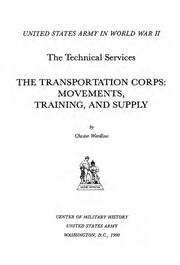
CMH Pub 10-20 The Transportation Corps: Movements, Training, And Supply PDF
Preview CMH Pub 10-20 The Transportation Corps: Movements, Training, And Supply
UNITED STATES ARMY IN WORLD WAR II The Technical Services THE TRANSPORTATION CORPS: MOVEMENTS, TRAINING, AND SUPPLY by Chesler Wardlow CENTER OF MILITARY HISTORY UNITED STATES ARMY WASHINGTON, D.C., 1990 Foreword The history of World War II is making increasingly clear the central fact that the tightest rein on the military effort of the United States in that war was imposed by transportation. As long as this nation fights overseas the same situation is likely to reoccur—a prospect that gives a special importance to the exposition of the subject in this series. The Army promptly recognized the im- portance of transportation when, as in World War I, it centralized its supervi- sion of this branch of its vast logistical effort in a Chief of Transportation and created (in July 1942) a Transportation Corps. The Army did not, and could not, control all the factors that entered into the movement of its men, munitions, and supplies. The larger story the reader must seek elsewhere— in the two volumes on Global Logistics and Strategy and in the theater volumes of the U.S. ARMY IN WORLD WAR IL Here the story is told from the records and point of view of the Army's Chief of Transporta- tion, Maj. Gen. Charles P. Gross. In this volume, the second in the group of three Transportation Corps volumes, Mr. Wardlow passes to the policies and methods adopted to move men and matériel within the continental United States and out to theaters of operations—the core of General Gross's mission— and to provide the Transportation Corps' quota of equipment and trained soldiers necessary to accomplish its oversea mission. ALBERT C. SMITH Washington, D. C. Maj. Gen., U. S. A. 7 June 1954 Chief of Military History vii The Author Mr. Chester Wardlow was pursuing graduate studies in Political Science at the University of Chicago when the United States entered World War I. In 1918, employed by the Shipping Board, he went overseas with the mission that became the American Section of the Allied Maritime Transport Council. From 1921 until 1935 he was connected with private shipping organizations. During the period 1935-41 he held the office of Sole Arbiter of the Trans-Atlantic Pas- senger Conference. In 1941 Mr. Wardlow was employed as Coordinator of Transportation for the Army and remained in that position until 1946. From 1946 until his retirement in 1954 he was the Chief Historian of the Transporta- tion Corps. He is the author of the first volume of the Transportation Corps subseries in the U.S. ARMY IN WORLD WAR II, published in 1951. viii Preface The purpose of this volume is twofold: to present and evaluate the machinery and the procedures employed by the Army Chief of Transportation in moving troops and military matériel within the United States and from the United States to the oversea theaters of operations, and to outline the methods used and the problems encountered by the Chief of Transportation in training the troops and providing the equipment and supplies needed to maintain effective transportation services in the oversea commands. The movement of troops and matériel was the basic and distinctive function of the Chief of Transportation, and for that reason the greater part of the book has been devoted to that aspect of his work. Training and supply functions were performed by other technical services as well as by the Transportation Corps, and since all technical services worked under the general direction of Army Services Forces headquarters, there was considerable similarity in the methods employed and the standards enforced. The discussion of training and supply is therefore confined to those aspects in which the Chief of Transporta- tion had unique responsibilities or encountered exceptional problems. Much of this account is presented by simply stating what the functions of the Chief of Transportation were and how he performed them, although his oper- ating difficulties and his disagreements with other agencies are treated as fully as seems warranted. During the prewar emergency period, as the United States steadily drifted toward open belligerency, one of the handicaps suffered by those concerned with military transportation was the lack of an adequate record of how the Transportation Service had functioned in World War I. The documented account given here should in large measure obviate a similar lack if the nation should again become involved in a major conflict. In the interest of completeness some matters that were discussed in The Transportation Corps: Responsibilities, Organization, and Operations are dealt with again, but the second treatment has been kept as brief as practicable and cross referenced to that volume. Since the discussion of movements, training, and supply activities can be better understood if the reader has some knowledge of the background of the Transportation Corps, its relations with other agencies, and the broad policies of the Chief of Transportation, these aspects of the Transportation Corps story are reviewed briefly in the introduction. Valuable information and opinions have been obtained from officers and civilian experts who were on the staff of the Chief of Transportation during the ix
